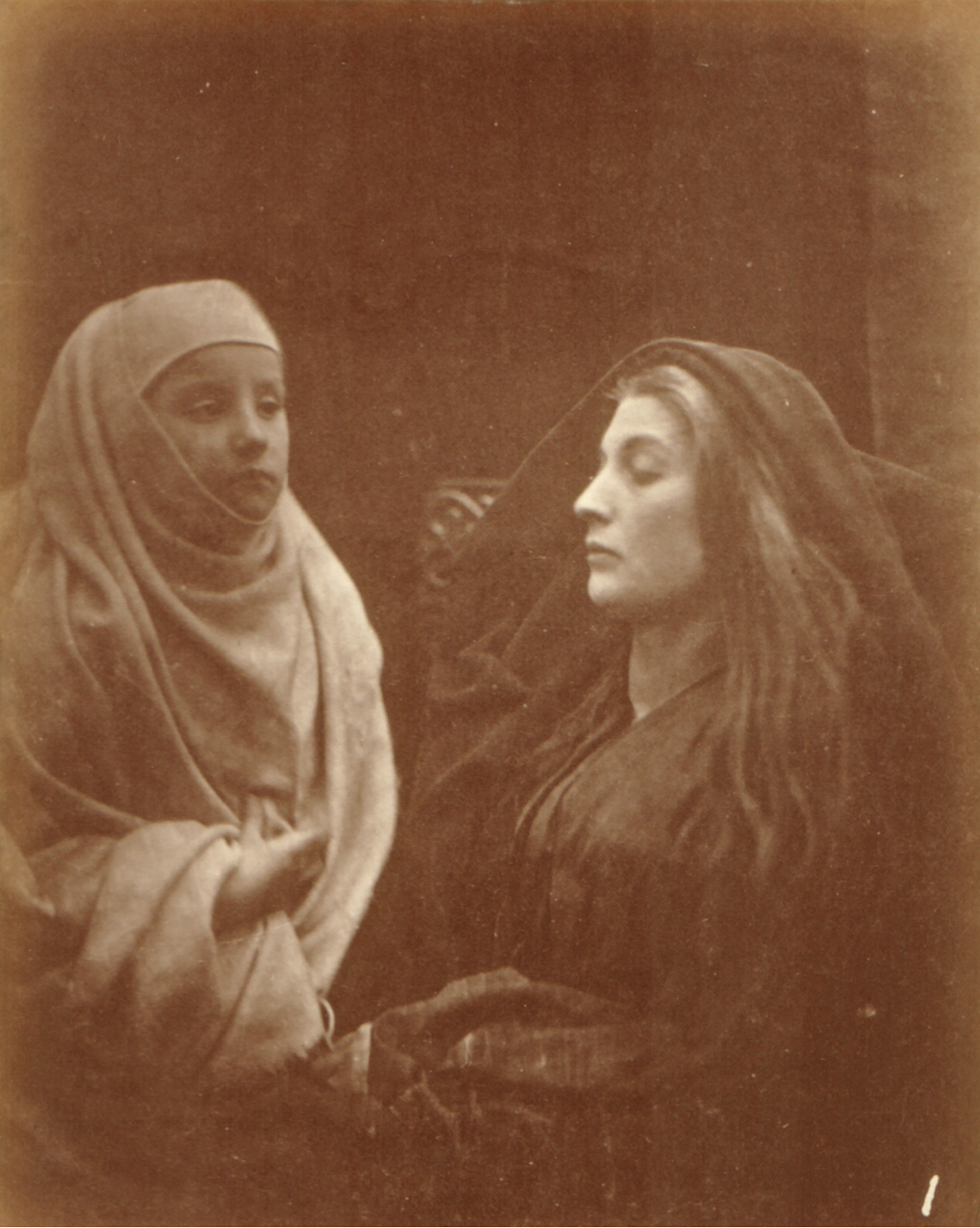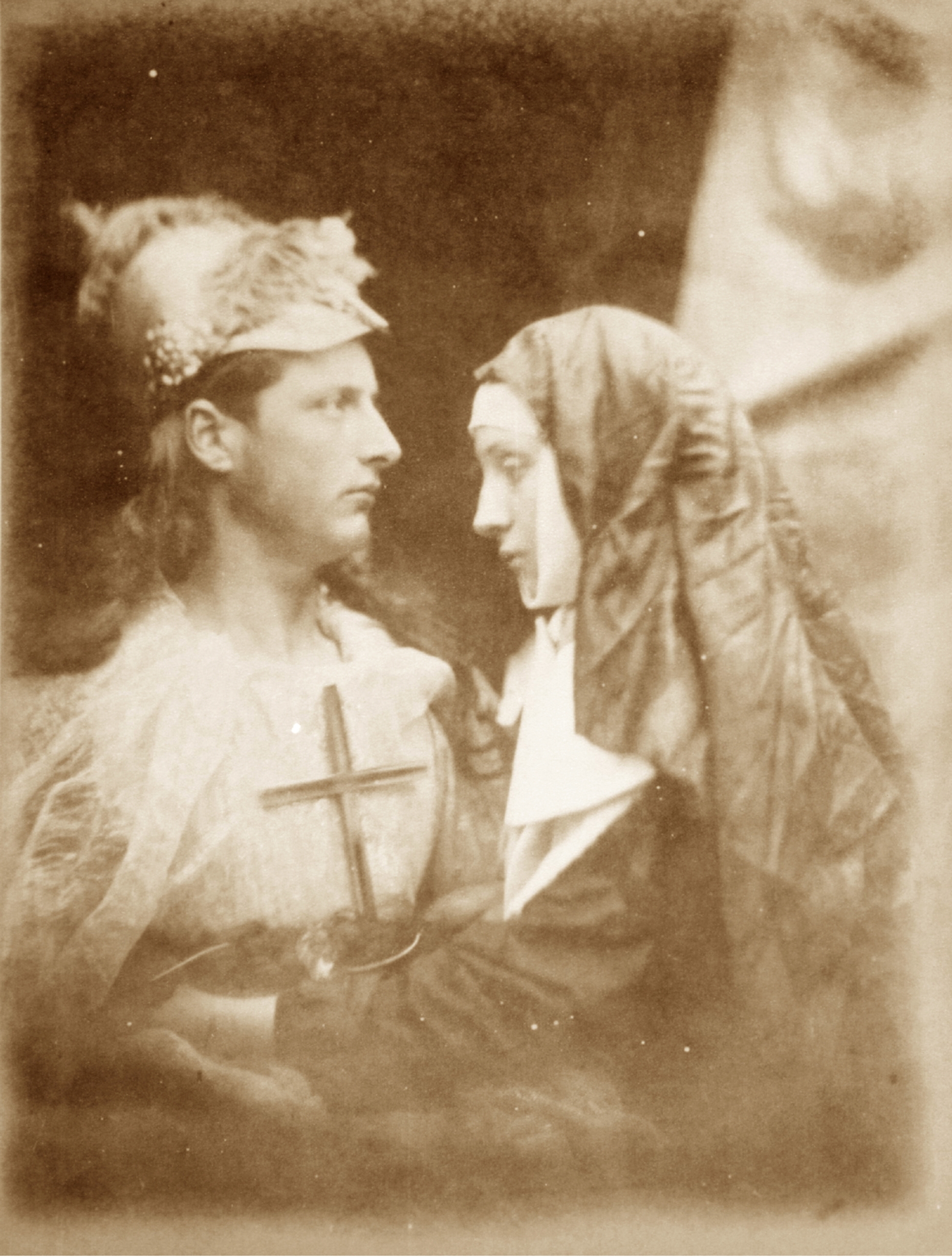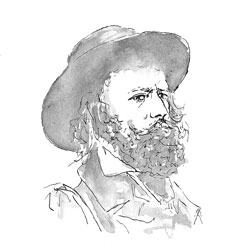Tennyson and Vision: Julia Margaret Cameron
Tennyson's Idylls of the King were illustrated with pioneering photographs by Julia Margaret Cameron. In this essay Claire Wilkinson introduces them and considers how poem and picture relate.
Julia Margaret Cameron was a pioneering photographer and a contemporary of Tennyson. The pair both lived in Freshwater on the Isle of Wight, Cameron moving there in 1860 having visited Tennyson's estate on the island. (Later they would both appear in Virginia Woolf's 1923 play actually called Freshwater.) Photography was both a young art in Victorian England and a rapidly developing medium. The first photograph had been taken in 1826 (requiring eight hours to expose!), yet by the end of the nineteenth century the photographic film, which used similar technology to today's film cameras, had been invented. Cameron began taking photographs in 1863, after receiving a camera for her 48th birthday. She was late to begin learning her art, but quickly became known for her photographic skill. It was Cameron who illustrated Tennyson's Idylls of the King at the author's request, with photographs imitating oil paintings in the style of the Pre-Raphaelite painters.
Both Tennyson and Cameron were interested in the style, which had begun as a school of thought in painting. Essentially, Pre-Raphaelite artists aimed to create work which was a direct and sincere portrayal of the subject; they were also interested in the connections between art and (particularly Romantic) poetry. Whilst Tennyson was not directly connected to the Pre-Raphaelites (notable members included Dante Gabriel Rossetti, a founder of the movement, whose younger sister Christina Rossetti came to be very influenced by Pre-Raphaelite thought), we may notice some similarities between Tennyson's work and the movement's ethos. 'The Lady of Shalott', for example, is set in a rather vivid dreamscape (based on Arthurian Camelot), similar in its strangeness to the setting of Rossetti's . The poem is also concerned with the connections between art and life. The lady of the poem is cursed to remain in a tower and weave a representation of the world she sees reflected in a mirror:
There she weaves by night and day
A magic web with colours gay.
She has heard a whisper say,
A curse is on her if she stay
To look down on Camelot.
She knows not what the curse may be,
And so she weaveth steadily.
(The Lady of Shalott, Part II stanza I, lines 37-43)
The world which the Lady of Shalott must imitate in her art is 'golden' and 'unclouded' when seen through the artist's mirror, yet when the curse is broken and the Lady leaves the tower, a different world is revealed; one which is 'dim' and 'raining'. Life will not imitate art; true art must imitate life. The Lady of Shalott thus accords with Pre-Raphaelite principles, despite being written sixteen years before the official formation of the movement.
Tennyson's Idylls of the King was a continuation of his fascination with the Arthurian themes seen in 'The Lady of Shalott'. A section of the poem was published as 'Morte D'Arthur' in 1842, and then expanded into a twelve-poem collection telling the tale of King Arthur. Cameron, by now a friend of Tennyson, admired the poem and created twelve photographs to accompany the text. The photographs appear in the 1875 book, Illustrations by Julia Margaret Cameron of Alfred Tennyson's Idylls of the King and Other Poems.
The Julia Margaret Cameron Trust runs a museum and gallery at her former home, Dimbola Lodge on the Isle of Wight (http://www.dimbola.co.uk). The photographs reproduced below come from their collection and are reproduced with their permission. Others can be found online, e.g. at The Camelot Project (http://www.lib.rochester.edu/camelot/ - search under Cameron's name). In order to respect copyright, we have not included all the images here, but they are easily found. Here you will find the details of the image, the part of the poem it refers to, and some things to think about. In each case, try thinking about how Cameron has expressed Tennyson's language visually.
1. Julia Margaret Cameron, 'The Parting of Sir Lancelot and Queen Guinevere'
And Lancelot ever promised, but remain'd
And still they met and met. Again she said,
O Lancelot if thou love me get thee hence
(Idylls of the King, Book XI - l. 92-94)
Thinking Points:
'but remain'd': Can you find a suitable gesture in the photograph to suggest that Lancelot and Guinevere don't want to be parted?
'if thou love me get thee hence': Does Cameron attempt to express this desire of Guinevere's? If so, how?

Julia Margaret Cameron, 'The Little Novice and the Queen', plate XI from The Idylls of the King, albumen print 1874.
2. Julia Margaret Cameron, 'Queen Guinevere and the Little Novice'
So the stately Queen abode
For many a week, unknown, among the nuns;
Nor with them mix'd, nor told her name, nor sought,
Wrapt in her grief, for housel or for shrift,
But communed only with the little maid,
Who pleased her with a babbling heedlessness
Which often lured her from herself.
(Idylls of the King, Book XI - l. 144-150)
Thinking Points:
'stately': Consider the facial expressions of the people in the photograph. Guinevere's chin is held high, and her eyes are averted. Is this 'stately'?
'Wrapt in her grief': Does the clothing chosen for the models help to accentuate this concept of being 'wrapt'?
'babbling heedlessness': Do you think that Cameron conveys the 'babbling heedlessness' of the child well?

Julia Margaret Cameron, 'Sir Galahad and the Pale Nun', plate IX from Idylls of the King, albumen print 1874
3. Julia Margaret Cameron, 'Sir Galahad and the Pale Nun'
O thou my love, whose love is one with mine.
I, maiden, round thee, maiden, bind my belt.
(Idylls of the King, Book VIII - l. 10-11)
Thinking Points:
'whose love is one with mine': How does Cameron express 'at one' in the photograph?
'I, maiden, round thee, maiden, bind my belt': This is a particularly visual image in the poem, and as such is easily depicted in the photograph. Do you think that enough emphasis is placed on the action of 'binding' the belt?
The costumes are again striking: do you think they help capture the moment in Tennyson?
Further Thinking
Cameron's photographs have received a lot of criticism over the years - do you think you could do better? You could try planning and even taking photographs to represent excerpts from the Tennyson's Idylls of the King like the ones below. Make sure that you use the language in the poem to inspire form and content in the photographs. How, for example, in a photograph, would you convey that Galahad is sitting in Merlin's chair?
1. Then on a summer night it came to pass,
While the great banquet lay along the hall,
That Galahad would sit down in Merlin's chair.
'The Holy Grail' (l. 179-181)
2. So saying, from the pavement he half rose,
Slowly, with pain, reclining on his arm,
And looking wistfully with wide blue eyes
'The Passing of Arthur' (l. 167-168)
3. She ceased, and made her lithe arm round his neck
Tighten, and then drew back, and let her eyes
Speak for her, glowing on him, like a bride's
On her new lord, her own, the first of men.
'Merlin and Vivien' (l. 612-615)
4. That night came Arthur home, and while he climbed,
All in a death-dumb autumn-dripping gloom,
The stairway to the hall, and looked and saw
The great Queen's bower was dark,--about his feet
A voice clung sobbing till he questioned it,
'What art thou?' and the voice about his feet
Sent up an answer, sobbing, 'I am thy fool,
And I shall never make thee smile again.'
'The Last Tournament' (l. 753-760)
If you come up with any photographs you are pleased with, send them to us in the form of a .jpeg, and we may well add them to the site.
